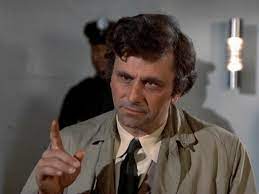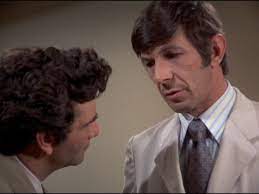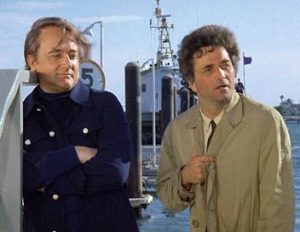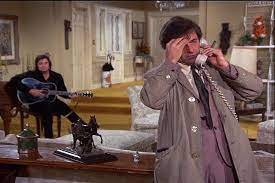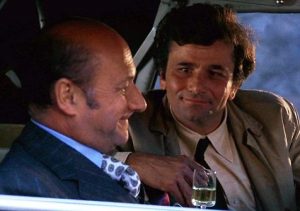
© A24 / IAC Films / Apple TV+
I recently watched The Tragedy of Macbeth (2021), directed by Joel Cohen (without, for the first time ever, his brother Ethan co-directing) and starring Denzel Washington as William Shakespeare’s king-stabbing, crown-grabbing Scotsman. Meanwhile, in the role of Macbeth’s spouse, the ruthless Lady Macbeth, is Cohen’s real-life spouse Frances McDormand. It’s difficult to sum up my reaction to the film. I suppose you could say: liked it… stopped liking it… started liking it again.
The opening sequence, the aftermath of the battle between Scotland and the combined armies of Ireland and Norway, takes place on a beach. Thanks to Bruno Delbonnel’s monochrome cinematography, it’s palely, clammily and impressively atmospheric. Mind you, within a couple of minutes of hearing the performers’ accents – Ralph Ineson speaking broad Yorkshire, Harry Melling speaking broad RP and Brendan Gleason speaking broad Irish – you realise this isn’t going to be a particularly Scottish take on the Scottish play.
Enter Washington’s Macbeth, speaking broad American, and Bertie Carvel’s Banquo. They encounter the Weird Sisters (Kathryn Hunter) and hear their fateful prophecies. Soon after, the prophecies start coming true as Macbeth is made Thane of Cawdor thanks to his valour during the battle. And the plot – literally a plot, with Washington and McDormand conspiring to kill Gleason’s King Duncan and seize the Scottish throne – is underway.
So, for me, the film gets off to a strong start. I went off it, however, when the action relocates to Macbeth’s castle, where Duncan spends the night as a guest, and we get the build-up, execution and aftermath of his murder. Ironically, this was because of something many critics have praised the film for, its stylised sets and lighting, which give the castle’s interior the look of a perspective-bending M.C. Escher illustration, shot in the manner of a German expressionist silent movie or a 1940s American film noir.
My problem was that the shafts of stark white light (necessary to produce the black shadows elsewhere) and the sense of silence, stillness and solidity evoked by the sets make a nonsense of Shakespeare’s theme that, by murdering Duncan and violating the human social order, Macbeth sparks a chain reaction with violent effects in the natural world too: “Where we lay / Our chimneys were blown down and, as they say / Lamentings heard i’ th’ air, strange screams of death / And prophesying, with accents terrible / Of dire combustion and confused events… / …Some say the earth / Was feverous and did shake.” Well, you don’t get any impression of falling-down chimneys, lamentings, dire combustion, confused events and feverous earthquakes in an environment as still and sombre as this. In fact, there’s little suggestion that night-time occurred at all – the castle windows seem to blaze permanently with light.
I actually didn’t respond well to the overall, stylised, sometimes artificial look of the film, though I suspect that’s just me. I spent some of my formative years in Scotland, so to me the places mentioned in the play – Glamis, Cawdor, Fife – aren’t just names but real geographical locations. I prefer Macbeth movies with proper Scottish landscapes, with primordial mountains, moors, glens and lochs that to my mind create an appropriate backdrop for the dark and bloody goings-on.

© A24 / IAC Films / Apple TV+
However, The Tragedy of Macbeth regained my interest later on. The sequence where Macbeth has his second meeting with the Weird Sisters is staged with wonderful inventiveness and thereafter the movie gets its second wind. The slaughter of Macduff’s family is impressively done too, conveying the cruelty of the deed without descending into a bloodbath. (As the first murderer assaults one of the young Macduff-lings, he utters the memorable Shakespearean cry, “What, you egg!”, although the punning follow-up line, “Young fry of treachery!” is excised here. Also removed is the doomed youngster’s exclamation, “He has kill’d me, mother!” At school, while my classmates and I studied Macbeth for the Scottish O-Grade, we found this really funny for some reason.)
One thing many critics have remarked upon is the age of the two leads. Washington and McDormand are both in their late middle-age, no longer able to have children. This makes their murder of Duncan and the seizing of the throne more egotistical – they aren’t doing it for their line, which doesn’t and won’t exist, but purely for themselves. Their childlessness, of course, contrasts with the fecundity of the two thorns in their sides. Banquo has a son, Fleance, and Macduff has a whole brood of kids. It also underlines Macbeth’s wariness of Banquo, for whom the Weird Sisters prophesise: “Thou shalt get kings, though thou be none.”
Elsewhere, my impression of The Tragedy of Macbeth was that some things worked well and other things less well. Kathryn Hunter is splendid as the Weird Sisters. There’s only one of them who’s flesh and blood, though that twisted, contorted body of hers seems to be inhabited by the spirits of all three. The figures of the other two only materialise in the physical world as reflections – Macbeth’s and Banquo’s first sighting of them, at the edge of a pool, is memorably creepy. Perhaps Hunter’s performance gets slightly too Andy Serkis at times, but it’s still very effective.
On the other hand, the promotion of the character of Ross (Alex Hassell) from being one of the original play’s interchangeable Scottish thanes to, here, being a Machiavellian, possibly even supernatural, manipulator who’s playing both sides – he delivers the warning to Lady Macduff about Macbeth’s evil intentions, but also turns up as the mysterious third murderer who does for Banquo, and there’s even a suggestion that he has a hand in Lady Macbeth’s suicide – is intriguing but doesn’t really come off. With the Weird Sisters, the play already has Machiavellian manipulators. It doesn’t need any more.

© StudioCanal / Film4
It’s interesting to compare this Macbeth with the cinematic adaptations that have come before. I preferred it to the Justin Kurzel-directed version, released in 2015, which despite a great cast – Michael Fassbender as Macbeth, Marion Cotillard as Lady Macbeth, David Thewlis as Duncan, Paddy Considine as Banquo, Sean Harris as Macduff – seems rather subdued, thanks to the amount of low-volume muttering and mumbling going on that takes the fire out of Shakespeare’s lines. It also chops out parts of the play that, while admittedly hammy, I’ve always enjoyed, for example, the post-regicide comedy relief with the porter, and most of the “Double, double toil and trouble / Fire burn and cauldron bubble” hijinks with the Weird Sisters. At least in The Tragedy of Macbeth these are reinstated. Stephen Root gives a funny turn as the porter and Joel Cohen seems to relish the macabre incantations of the Weird Sisters: “Finger of birth-strangled babe / Ditch-deliver’d by a drab / Liver of blaspheming Jew / Gall of goat and slips of yew…” Well, he did start his movie career as an assistant editor on Sam Raimi’s The Evil Dead (1981).
Still, the 2015 Macbeth looks lovely and it satisfies my craving for proper Scottish landscapes in a Macbeth movie. Many of its outdoor scenes were shot on the Isle of Skye, although admittedly parts of it were also filmed in England, at Bamburgh Castle in Northumberland and Ely Cathedral in Cambridgeshire. Also visually striking is the sequence where Macbeth squares up to Macduff. Their swordfight takes place against an infernal, almost hallucinogenic orange-red backdrop while Birnam Wood burns off-screen. For yes, the scriptwriters cooked up – and ‘cook’ is the operative word – a novel way of bringing Birnam Wood to the castle on Dunsinane Hill.
For me, though, the best movie Macbeth is Roman Polanski’s version of it back in 1971, which had Jon Finch and Francesca Annis in the lead roles. This made a big impression on me. I was 15 when I saw it, so no doubt one reason why I took to it was because the film’s qualities – its simultaneous bleakness, bloodiness, bawdiness, gothic-ness, gorgeousness, rebelliousness and artiness – mirrored the mix of emotions and hormones seething at the time in my teenaged self. And no doubt I felt a connection with the film too because Finch and Annis were both so young when they made it. In fact, their youthfulness suggests they have little power to control their destinies. They’re swept along with events, propelled by dark forces that are both political and supernatural.
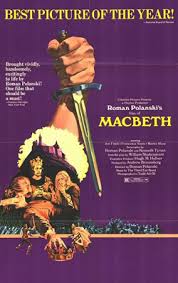
© Playboy Productions / Columbia Pictures
Polanski’s Macbeth was disliked by many critics, upset by its violence and disturbed by the fact that Polanski’s recent past had been pretty violent too. In August 1969, his pregnant wife Sharon Tate and four others were butchered at his home in Beverly Hills by followers of the hippie-cult lunatic Charles Manson. Pauline Kael, the film critic for the New Yorker, even wondered if Polanski’s staging of the murder of Macduff’s family was an attempt to replicate the carnage that Manson had authored in his own life. Famously, the film’s screenwriter, Kenneth Tynan, challenged Polanski about the amount of blood shown in this scene – to which the director retorted, “You should have seen my house last summer.”
Incidentally, the exteriors in Polanski’s Macbeth look rugged enough to be Scottish, but the film was actually shot elsewhere, in Wales (including Snowdonia) and north-eastern England. And, yes, Northumberland’s Bamburgh Castle makes an appearance in this version too.
One other cinematic Macbeth I’ve seen is the 1948 production directed by, and starring, Orson Welles. I watched this on TV a long time ago and wasn’t impressed by its apparent staginess and melodramatics – by then I was in thrall to the Polanski version. However, lately, I’ve watched a few parts of it on Youtube and revised my opinion of it somewhat. Yes, it’s cheap. Welles made it for Republic Pictures, a studio that normally specialised in low-budget westerns, had to shoot it on some of Republic’s leftover western sets, and had only a 23-day shooting schedule. But scenes like Act 3 Scene 4, where Banquo’s ghost shows up at the feast with ‘no speculation’ in its eyes and shaking its ‘gory locks’ at his killer, are surprisingly well-staged. Though I suppose you’d expect that from Welles.
There are problems, however. Though he was only 33 at the time, Welles was already getting portly and resembled Falstaff more than Macbeth. It doesn’t help that he appears in an eccentric costume that, he grumbled later, made him look like the Statue of Liberty.
And then there are the accents – dear God. Welles’s American cast dial the fake twee Scottish-ness up to 11 and roll their ‘r’s for minutes at a time. Jeanette Nolan as Lady Macbeth is shrill and hard to listen to and even Welles himself, during his more excitable moments, sounds like Scotty in the original series of Star Trek (1966-69). Meanwhile, the Weird Sisters’ accents are so piercing they remind me of those advertisements that Scottish children’s entertainer and showbiz personality Molly Weir used to make for Flash, the household cleaning agent, back in the 1970s: “Flash cleans baths without scr-r-r-r-ratching!”
And on that topic… While one of the play’s strengths is that it can be adapted to countless different settings and styles, I would one day like to see a truly Scottish film version of Macbeth, with authentic Scottish actors and accents as well as those brooding Scottish landscapes I’ve talked about. You can’t claim, as you might have been able to in the past, that there aren’t enough bankable Scottish actors to draw audiences to it. Not with the likes of Peter Capaldi, Robert Carlyle, Robbie Coltrane, Martin Compston, James Cosmo, Brian Cox, Kate Dickie, Lindsay Duncan, Karen Gillan, Shirley Henderson, Jack Lowden, James McAvoy, Kelly Macdonald, Ewan McGregor, Kevin McKidd, Bill Paterson, Dougray Scott, Ken Stott, David Tennant, etc., on the go nowadays.
Hell, I’d even pay money to see Gerald Butler as Macbeth. Cawdor Has Fallen, anyone?

© Mercury Productions / Republic Pictures

